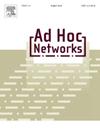Device Fingerprinting in Power Line Communications
IF 4.8
3区 计算机科学
Q1 COMPUTER SCIENCE, INFORMATION SYSTEMS
引用次数: 0
Abstract
Power Line Communication (PLC) use existing electrical infrastructure for data transmission but are susceptible to security threats such as spoofing and impersonation attacks due to their open nature. This paper proposes a novel Device Fingerprinting (DF) approach for device authentication in PLC systems. The approach leverages hardware-induced imperfections in signals transmitted over power lines to identify devices based on their physical-layer characteristics.
We develop a methodology that converts raw In-Phase Quadrature (IQ) samples from PLC channels into images, enabling the use of Convolutional Neural Networks for device classification. Our approach demonstrates the feasibility of CNN-based DF in PLC environments using only physical-layer information from received signals. Our experimental validation uses 8 Software Defined Radios and 2 power line couplers in real-world PLC measurements. We evaluate multiple Convolutional Neural Network (CNN) architectures and demonstrate that the PLC device fingerprint consists of two components: radio-specific and coupler-specific characteristics. The results show classification accuracy exceeding 0.9 across different configurations, establishing the viability of DF-based authentication in PLC systems without requiring additional security layers.
电力线通信中的设备指纹识别
电力线通信(PLC)使用现有的电力基础设施进行数据传输,但由于其开放性,容易受到欺骗和冒充攻击等安全威胁。提出了一种新的用于PLC系统中设备认证的设备指纹(DF)方法。该方法利用电力线上传输的信号中硬件引起的缺陷,根据设备的物理层特征来识别设备。我们开发了一种方法,将来自PLC通道的原始相位正交(IQ)样本转换为图像,从而可以使用卷积神经网络进行设备分类。我们的方法证明了基于cnn的DF在PLC环境中仅使用来自接收信号的物理层信息的可行性。我们的实验验证在实际PLC测量中使用8个软件定义无线电和2个电源线耦合器。我们评估了多个卷积神经网络(CNN)架构,并证明PLC设备指纹由两个组成部分组成:无线电特定特征和耦合器特定特征。结果表明,在不同的配置下,分类精度超过0.9,在PLC系统中建立了基于df的身份验证的可行性,而不需要额外的安全层。
本文章由计算机程序翻译,如有差异,请以英文原文为准。
求助全文
约1分钟内获得全文
求助全文
来源期刊

Ad Hoc Networks
工程技术-电信学
CiteScore
10.20
自引率
4.20%
发文量
131
审稿时长
4.8 months
期刊介绍:
The Ad Hoc Networks is an international and archival journal providing a publication vehicle for complete coverage of all topics of interest to those involved in ad hoc and sensor networking areas. The Ad Hoc Networks considers original, high quality and unpublished contributions addressing all aspects of ad hoc and sensor networks. Specific areas of interest include, but are not limited to:
Mobile and Wireless Ad Hoc Networks
Sensor Networks
Wireless Local and Personal Area Networks
Home Networks
Ad Hoc Networks of Autonomous Intelligent Systems
Novel Architectures for Ad Hoc and Sensor Networks
Self-organizing Network Architectures and Protocols
Transport Layer Protocols
Routing protocols (unicast, multicast, geocast, etc.)
Media Access Control Techniques
Error Control Schemes
Power-Aware, Low-Power and Energy-Efficient Designs
Synchronization and Scheduling Issues
Mobility Management
Mobility-Tolerant Communication Protocols
Location Tracking and Location-based Services
Resource and Information Management
Security and Fault-Tolerance Issues
Hardware and Software Platforms, Systems, and Testbeds
Experimental and Prototype Results
Quality-of-Service Issues
Cross-Layer Interactions
Scalability Issues
Performance Analysis and Simulation of Protocols.
 求助内容:
求助内容: 应助结果提醒方式:
应助结果提醒方式:


